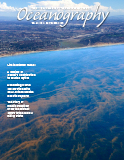Full Text
This September 2020 Oceanography doesn’t have a special issue section, but if I had to provide a title for the issue, it would be “Reflections.” Subjects the articles and commentaries ask us to reflect on include racism and gender bias in the ocean sciences, the benefits and pitfalls of conducting conferences virtually, lessons learned while developing broader impact activities, and the optical oceanography legacy of Angelo Secchi, among others.
Some of the topics addressed here may take us out of our comfort zones. Hardy and Rozwadowski reexamine the legacy of nineteenth-century naval officer and early ocean scientist Matthew Fontaine Maury. While Maury did not own slaves, his actions supported the institution of slavery. Our authors pose the question, what should ocean scientists “do with this new found awakening to Maury’s dual admirable and reprehensible legacies?” Applying contemporary standards to centuries-old conduct is a challenging exercise, but we need to take the time to reflect on how we teach about such historical figures as we simultaneously develop strategies to increase diversity in the geosciences.
Glüder’s commentary addresses gender bias by examining an extremely tangible example: why don’t many research vessels have an adequate supply of survival equipment in smaller sizes suitable for women—and also for men who do not fit the “50th percentile North American male” physique. The issue here concerns not only survival in frigid ocean waters but also the feeling of not belonging caused by the lack of proper safety equipment.
The inclusion of “broader impact” activities is a requirement for many science proposals submitted to US federal agencies. Orellana et al. describe how they developed successful high school ocean science curriculum modules and leveraged several grants to retain continuity of the project. They also reflect on the solutions that enabled the success of their broader impacts project and share those lessons learned.
Thrust into this COVID world of relative isolation, conferences have had to test the waters of the virtual world. Power et al. share their experiences conducting a Young Coastal Scientists and Engineers Conference online. They reflect on the numerous positive outcomes of holding a virtual conference, some unexpected, and note that even when in-person conferences are again possible, they will likely always incorporate some online component.
The hands-on oceanography activity, “Sound and the Seafloor,” by Levine et al. introduces students to the concept of acoustic reflection (sorry) by having them build their own simplified echosounders, deploy their instruments to map a transect, and use the data to explore sampling resolution. The article does have a section called Reflection (really) in which the authors suggest questions that can stimulate students to consider the implications of their observations and the sources of variability.
Pitarch illuminates the optical oceanographic legacy of Angelo Secchi, the nineteenth century Italian astrophysicist widely known for the reflective (sorry again) white disk that bears his name. In this article, Pitarch calls attention to a mostly ignored 1865 cruise report in which Secchi addresses such questions as “how the angle of the sun, the disk’s color and directional reflectance, the disk’s diameter, the ship’s shadow, and cloudiness influence the transparency measurements.”
In her Revelle Lecture article, Rochman tells the story the history of research surrounding plastic pollution in the ocean. She reflects on how a little more than a dozen years ago, the words plastic and pollution were not yet linked as an environmental issue, but today plastic pollution has become a global policy issue with research going in many new directions.
Other articles in this issue describe new and exciting ocean science and engineering areas and take look at an important topic of study that has been largely neglected. In their Breaking Waves article, Saad et al. demonstrate how it is possible to integrate artificial intelligence methods into an autonomous underwater vehicle to accelerate the analysis of the spatiotemporal distribution of microorganisms in the ocean. In their Regular Issue Feature, Garwood et al. use idealized numerical simulations to show the importance of accounting for horizontal motions in internal waves when studying coastal ecosystems.
If I may provide a couple of other important reflections from this September issue: I am particularly pleased and proud to see the number of graduate students and early career scientists who are first authors (Garwood, Glüder, Levine, Saad) or coauthors (in Levine et al., Power et al., Saad et al.) of articles. I am also very encouraged that women are first authors (Garwood, Glüder, Hardy, Orellana, Power, Rochman, Saad) on seven of the nine articles—perhaps a counterbalance to some of the data coming out that indicates women are publishing less during COVID.
One final reflection. While Oceanography has “grown up” considerably since it was first published in 1988, this September issue also displays how we have remained true to our roots. As the first Oceanography editor David A. Brooks wrote in the inaugural magazine issue, “the guiding principle and editorial policy of Oceanography Magazine will remain steadfast and inviolate: we intend to serve, promote, and chronicle all aspects of ocean science and its applications, and we invite you to join in the adventure.”
– Ellen S. Kappel, Editor

